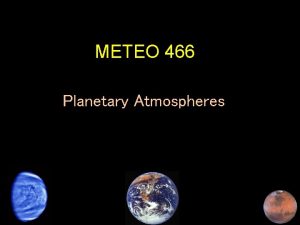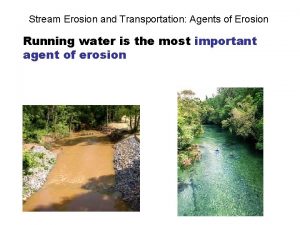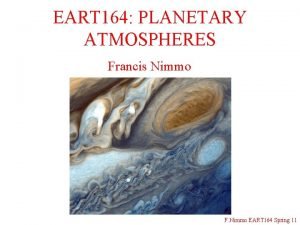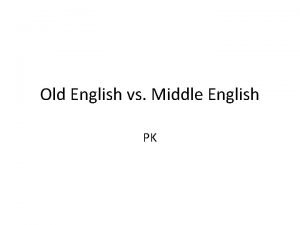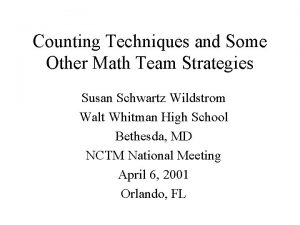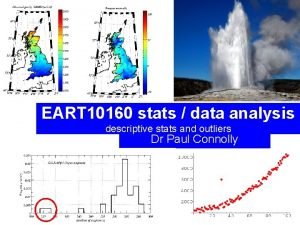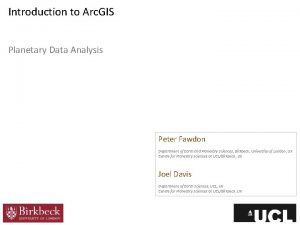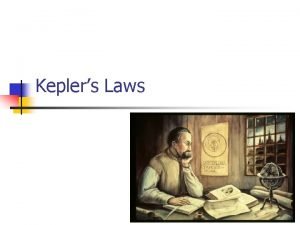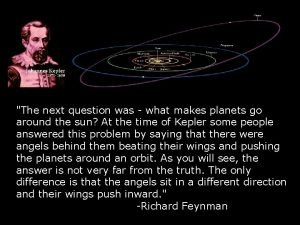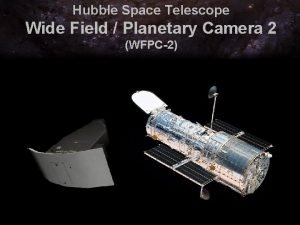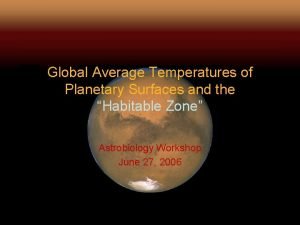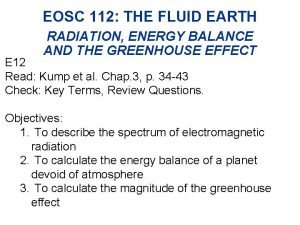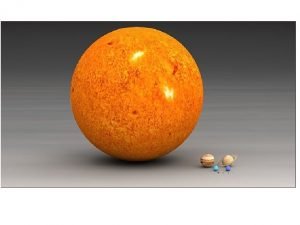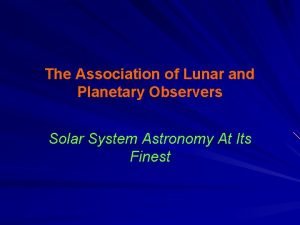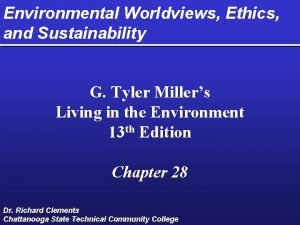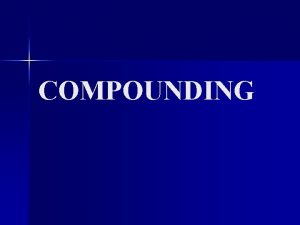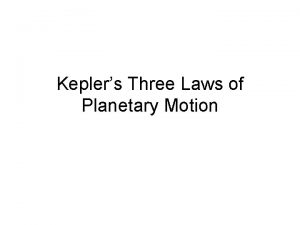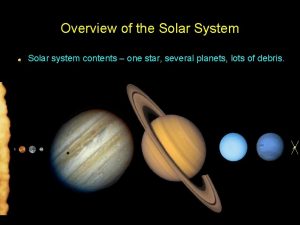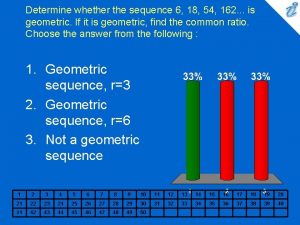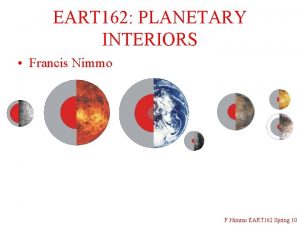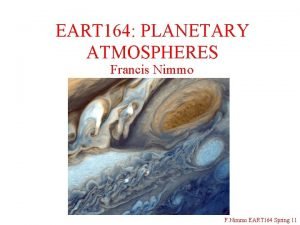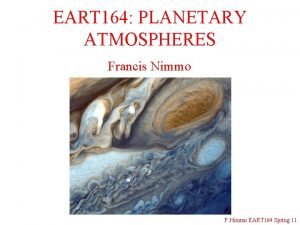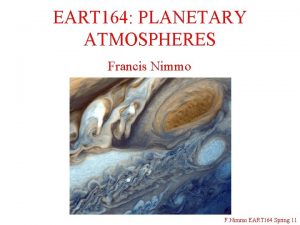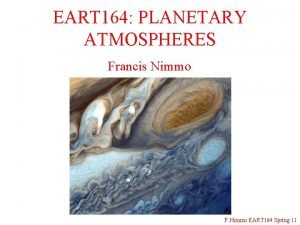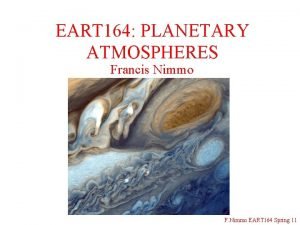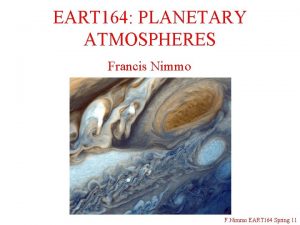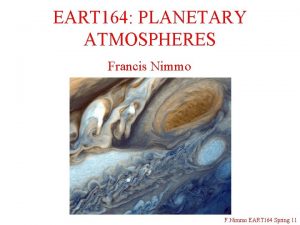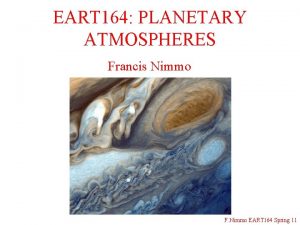EART 162 PLANETARY INTERIORS Francis Nimmo F Nimmo








































- Slides: 40

EART 162: PLANETARY INTERIORS Francis Nimmo F. Nimmo EART 162 Spring 10

Last week - Seismology • Seismic velocities tell us about interior properties • Adams-Williamson equation allows us to relate density directly to seismic velocities • Travel-time curves can be used to infer seismic velocities as a function of depth • Midterm F. Nimmo EART 162 Spring 10

This Week – Fluid Flow & Convection • • Fluid flow and Navier-Stokes Simple examples and scaling arguments Post-glacial rebound Rayleigh-Taylor instabilities What is convection? Rayleigh number and boundary layer thickness See Turcotte and Schubert ch. 6 F. Nimmo EART 162 Spring 10

Viscosity • Young’s modulus gives the stress required to cause a given deformation (strain) – applies to a solid • Viscosity is the stress required to cause a given strain rate – applies to a fluid • Viscosity is basically the fluid’s resistance to flow elastic Young’s modulus viscosity • Kinematic viscosity h measured in Pa s • [Dynamic viscosity n=h/r measured in m 2 s-1] • Typical values for viscosity: water 10 -3 Pa s, basaltic lava 104 Pa s, ice near melting 1014 Pa s, mantle 1021 Pa s • Viscosity often temperature-dependent (see Week 3) F. Nimmo EART 162 Spring 10

Defining Viscosity • Recall • Viscosity is the stress generated for a given strain rate • Example – moving plate: u h d (Shear) stress s required to generate velocity gradient u / d (= ) Viscosity h=s d / u • Example – moving lava flow: Driving shear stress = rgd sinq a d Surface velocity = rgd 2 sinq / h e. g. Hawaiian flow h=104 Pa s q=5 o d=3 m -1 (walking pace) gives u=2 ms q F. Nimmo EART 162 Spring 10

Adding in pressure • In 1 D, shear stress (now using t) is • Let’s assume u only varies in the y direction Viscous force (x direction, Fluid velocity u y per unit volume): dy x dx Pressure force (x direction, per unit volume): Why the minus sign? F. Nimmo EART 162 Spring 10

Putting it together • Total force/volume = viscous + pressure effects • We can use F=ma to derive the response to this force What does this mean? • So the 1 D equation of motion in the x direction is What does each term represent? • In the y-direction, we would also have to add in buoyancy forces (due to gravity) F. Nimmo EART 162 Spring 10

Navier-Stokes • We can write the general (3 D) formula in a more compact form given below – the Navier-Stokes equation • The formula is really a mnemonic – it contains all the physics you’re likely to need in a single equation • The vector form given here is general (not just Cartesian) Yuk! Inertial term. Pressure Source of turbulence. gradient See next slide. Buoyancy force (e. g. Diffusion-like viscosity Zero for steadythermal or electromagnetic) term. Warning: is state flows is a unit vector complicated, especially in non-Cartesian geom. F. Nimmo EART 162 Spring 10

Reynolds number • Is the inertial or viscous term more important? • We can use a scaling argument to get the ratio Re: a Re Here L is a characteristic lengthscale of the problem • Re is the Reynolds number and tells us whether a flow is turbulent (inertial forces dominate) or not • Fortunately, many geological situations allow us to neglect inertial forces (Re<<1) • E. g. what is Re for the convecting mantle? F. Nimmo EART 162 Spring 10

Example 1 – Channel Flow L y 0 x u P 2 P 1 2 d (Here u doesn’t vary in x-direction) • 2 D channel, steady state, u=0 at y=+d and y=-d a • Max. velocity (at centreline) = (DP/L) d 2/2 h • Does this result make sense? • We could have derived a similar answer from a scaling argument – how? F. Nimmo EART 162 Spring 10

Example 2 – falling sphere r Steady-state. What are the important terms? a u h An order of magnitude argument gives drag force ~ hur Is this dimensionally correct? The full answer is 6 phur, first derived by George Stokes in 1851 (apparently under exam conditions) By balancing the drag force against the excess weight of the sphere (4 pr 3 Drg/3 ) we can obtain the terminal velocity (here Dr is the density contrast between sphere and fluid) F. Nimmo EART 162 Spring 10

Example 3 – spreading flow y h(x, t) u d x Low Re, roughly steady-state. What are the important terms? Conservation of mass gives (why? ) As long as d >>h, we get: a What kind of equation is this? Does it make physical sense? Where might we apply it on Earth? F. Nimmo EART 162 Spring 10

Postglacial Rebound ice w L mantle • Postglacial rebound problem: How long does it take for the mantle to rebound? • Two approaches: – Scaling argument – Stream function j – see T&S • Scaling argument: • Assume u is constant (steady flow) and that u ~ dw/dt • We end up with decay constant • What does this equation mean? a F. Nimmo EART 162 Spring 10

Prediction and Observations • Scaling argument gives: How does this time constant compare with that for spreading flow? Hudson’s Bay deglaciation: L~1000 km, t=2. 6 ka So h~2 x 1021 Pa s So we can infer the viscosity of the mantle http: //www. geo. ucalgary. ca/~wu/TUDelft/Introduction. pdf A longer wavelength load would sample the mantle to greater depths – higher viscosity F. Nimmo EART 162 Spring 10

Rayleigh-Taylor Instability b r 1 m b r 2 m • This situation is gravitationally unstable if r 2 < r 1 : any infinitesimal perturbation will grow • What wavelength perturbation grows most rapidly? • The full solution is v. complicated (see T&S 6 -12) – so let’s try and think about it physically. . . L u 1 L l l u 2 u 1 b F. Nimmo EART 162 Spring 10

R-T Instability (cont’d) • Recall from Week 5: dissipation per unit volume • We have two contributions to total dissipation ( • By adding the two contributions, we get ) term a term • What wavelength minimizes the dissipation? • We end up with dissipation minimized at lmin=1. 26 b • This compares pretty well with the full answer (2. 57 b) and saves us about six pages of maths F. Nimmo EART 162 Spring 10

R-T instability (cont’d) • The layer thickness determines which wavelength minimizes viscous dissipation • This wavelength is the one that will grow fastest • So surface features (wavelength) tell us something about the interior structure (layer thickness) Salt domes in S Iran. Dome spacing of ~15 km suggests salt layer thickness of ~5 km, in agreement with seismic observations ~50 km F. Nimmo EART 162 Spring 10

Convection Cold - dense • Convection arises because fluids expand decrease in density when heated Fluid • The situation on the right is gravitationally unstable – hot fluid will tend to rise • But viscous forces oppose fluid motion, so Hot - less dense there is a competition between viscous and (thermal) buoyancy forces • So convection will only initiate if the buoyancy forces are big enough • What is the expression for thermal buoyancy forces? F. Nimmo EART 162 Spring 10

Conductive heat transfer • Diffusion equation (1 D, Cartesian) Advected Conductive component Heat production • Thermal diffusivity k=k/r. Cp (m 2 s-1) • Diffusion timescale: F. Nimmo EART 162 Spring 10

Convection equations • There are two: one controlling the evolution of temperature, the other the evolution of velocity • They are coupled because temperature affects flow (via buoyancy force) and flow affects temperature (via the advective term) Navier. Stokes Thermal Evolution Buoyancy force Note that here the N-S equation is neglecting the inertial term Advective term • It is this coupling that makes solving convection problems hard F. Nimmo EART 162 Spring 10

Initiation of Convection • Recall buoyancy forces favour motion, viscous forces oppose it d • Another way of looking at the problem is there are two competing timescales – what are they? a Top temperature T 0 d Incipient upwelling Hot layer Bottom temp. T 1 • Whether or not convection occurs is governed by the dimensionless (Rayleigh) number Ra: • Convection only occurs if Ra is greater than the critical Rayleigh number, ~ 1000 (depends a bit on. F. Nimmo geometry) EART 162 Spring 10

Constant viscosity convection • Convection results in hot and cold boundary layers and an isothermal interior • In constant-viscosity convection, top and bottom b. l. have same thickness • • cold T 0 (T 0+T 1)/2 d Isothermal interior hot T 1 d d T 1 Heat is conducted across boundary layers In the absence of convection, heat flux So convection gives higher heat fluxes than conduction The Nusselt number defines the convective efficiency: F. Nimmo EART 162 Spring 10

Boundary layer thickness d • We can balance the timescale for conductive thickening of the cold boundary layer against the timescale for the cold blob to descend to obtain an expression for the b. l. thickness d: d d a • So the boundary layer gets thinner as convection becomes more vigorous • Also note that d is independent of d. Why? • We can therefore calculate the convective heat flux: F. Nimmo EART 162 Spring 10

Example - Earth • Does this equation make sense? • Plug in some parameters for the terrestrial mantle: r=3000 kg m-3, g=10 ms-2, a=3 x 10 -5 K-1, k=10 -6 m 2 s-1, h=3 x 1021 Pa s, k=3 W m-1 K-1, (T 1 -T 0) =1500 K • We get a convective heat flux of 170 m. Wm-2 • This is about a factor of 2 larger than the actual terrestrial heat flux (~80 m. Wm-2) – not bad! • NB for other planets (lacking plate tectonics), d tends to be bigger than these simple calculations would predict, and the convective heat flux smaller • Given the heat flux, we can calculate thermal evolution F. Nimmo EART 162 Spring 10

Summary • Fluid dynamics can be applied to a wide variety of geophysical problems • Navier-Stokes equation describes fluid flow: • Post-glacial rebound timescale: • Behaviour of fluid during convection is determined by a single dimensionless number, the Rayleigh number Ra F. Nimmo EART 162 Spring 10

End of lecture • Supplementary material follows F. Nimmo EART 162 Spring 10

Thermodynamics & Adiabat • A packet of convecting material is often moving fast enough that it exchanges no energy with its surroundings • What factors control whether this is true? • As the convecting material rises, it will expand (due to reduced pressure) and thus do work (W = P d. V) • This work must come from the internal energy of the material, so it cools • The resulting change in temperature as a function of pressure (d. T/d. P) is called an adiabat • Adiabats explain e. g. why mountains are cooler than valleys F. Nimmo EART 162 Spring 10

Adiabatic Gradient (1) • If no energy is added or taken away, the entropy of the system stays constant • Entropy S is defined by Here d. Q is the amount of energy added to the system (so if d. Q=0, then d. S=0 also and the system is adiabatic) • What we want is at constant S. How do we get it? • We need some definitions: Specific heat capacity (at constant P) Thermal expansivity Maxwell’s identity F. Nimmo EART 162 Spring 10

T Adiabatic Gradient (2) • We can assemble these pieces to get the z adiabatic temperature gradient: adiabat • NB You’re not going to be expected to reproduce the derivation, but you do need to learn the final result • An often more useful expression can be obtained by converting pressure to depth (how? ) a • What are typical values for terrestrial planets? F. Nimmo EART 162 Spring 10

Incompressibility & Stream Function • In many fluids the total volume doesn’t change dx dy u(x) v(y) u(x+dx) a v(y+dy) If V 1=V 2 then Incompressibility condition • We can set up a stream function j which automatically satisfies incompressibility and describes both the horizontal and the vertical velocities: Note that these satisfy incompressibility F. Nimmo EART 162 Spring 10

Stream Function j • Only works in 2 dimensions • Its usefulness is we replace u, v with one variable j Check signs here! Differentiate LH eqn. w. r. t. z and RH w. r. t x a The velocity field of any 2 D viscous flow satisfies this equation F. Nimmo EART 162 Spring 10

Postglacial rebound and j (1) • Biharmonic equation for viscous fluid flow • Assume (why? ) j is a periodic function j=sin kx Y(y) Here k is the wavenumber = 2 p/l • After a bit of algebra, we get a • All that is left (!) is to determine the constants which are set by the boundary conditions – in real problems, this is often the hardest bit • What are the boundary conditions? • u=0 at z=0, v=dw/dt at z=0, u=v=0 at large z F. Nimmo EART 162 Spring 10

Postglacial rebound and j (2) • Applying the boundary conditions we get a • We have dw/dt = : 1 • Vert. viscous stress at surface (z=0) balances deformation: Why can we ignore this term? • For steady flow, we can derive P from Navier-Stokes a 2 • Finally, eliminating A from 1 and 2 we get (at last!): This ought to look familiar. . . F. Nimmo EART 162 Spring 10

Postglacial rebound (concluded) • So we get exponential decay of topography, with a time constant depending on wavenumber (k) and viscosity (h) • Same result as we got with the scaling argument! • Relaxation time depends on wavelength of load • Relaxation time depends on viscosity of fluid F. Nimmo EART 162 Spring 10

Convection Cold - dense • Convection arises because fluids expand decrease in density when heated Fluid • The situation on the right is gravitationally unstable – hot fluid will tend to rise • But viscous forces oppose fluid motion, so Hot - less dense there is a competition between viscous and (thermal) buoyancy forces • So convection will only initiate if the buoyancy forces are big enough • Note that this is different to the Rayleigh-Taylor case: thermal buoyancy forces decay with time (diffusion), compositional ones don’t • What is the expression for thermal buoyancy F. Nimmo forces? EART 162 Spring 10

F. Nimmo EART 162 Spring 10

Two Dimensions. . . • In 1 D, shear stress (now using t) is x txy v y • In 2 D, there are three different stresses: txy Shear stress txx u Normal stresses tyy • Where do the factors of 2 come from? p(y)dx p(x)dy dy dx p(y+dy)dx • Force due to pressure (x direction, per unit cross-sectional area): p(x+dx)dy a 1 F. Nimmo EART 162 Spring 10

Viscous forces on an element (1) x y txy v u dy dx tyy txx • Viscous force (x direction, per unit cross-sectional area): a 2 • Total force balance given by viscous + pressure forces 1 + 2 • After some algebra, we get total force in x-direction: a Note that force in x-direction only depends on velocity in x-direction and the x-gradient of pressure F. Nimmo EART 162 Spring 10

Viscous forces on an element (2) • In the y-direction, body forces can also be important • Otherwise, the analysis is the same as before • We can use F=ma to derive the response to this force What does this mean? • So the equations of motion in x and y directions are F. Nimmo EART 162 Spring 10

Putting it together • x-direction • y-direction Pressure gradient • Special cases: Viscous terms Body force – Steady-state – Du/Dt=0 – One-dimension (e. g. v=0, u only varies in y direction) F. Nimmo EART 162 Spring 10
 Francis nimmo
Francis nimmo Palladian interior design
Palladian interior design Aakaar interiors
Aakaar interiors Genesis 11 1-9 nkjv
Genesis 11 1-9 nkjv Meteo eart
Meteo eart Eart
Eart Eart
Eart Old english vs middle english examples
Old english vs middle english examples Google maps webgl
Google maps webgl Googol eart
Googol eart How to plot
How to plot Nimmo technique
Nimmo technique Jennifer nimmo
Jennifer nimmo Planetary disc
Planetary disc Environmental world view
Environmental world view Planetary data analysis
Planetary data analysis Prius planetary gear animation
Prius planetary gear animation Kepler's law of planetary motion
Kepler's law of planetary motion Stewardship worldview definition
Stewardship worldview definition Planetary systems
Planetary systems Kepler law formula
Kepler law formula Wide field and planetary camera 2
Wide field and planetary camera 2 Jordan yelinek
Jordan yelinek Planetary temperature calculator
Planetary temperature calculator Planetary energy balance
Planetary energy balance Law of planetary motion
Law of planetary motion Planetary positions today
Planetary positions today Planetary protection
Planetary protection Mars, jupiter, and saturn show retrograde motion because
Mars, jupiter, and saturn show retrograde motion because Association of lunar and planetary observers
Association of lunar and planetary observers Environmental wisdom worldview
Environmental wisdom worldview Planetary model
Planetary model Planetary mixer definition
Planetary mixer definition 3 laws of planetary motion
3 laws of planetary motion Nasa planetary science
Nasa planetary science What factor causes global wind patterns
What factor causes global wind patterns Planetary systems
Planetary systems Speed velocity and acceleration quiz
Speed velocity and acceleration quiz Fourth root of 162
Fourth root of 162 Hlinex, 0,1,2,3 hlinef (x),6,18,54,162 hline
Hlinex, 0,1,2,3 hlinef (x),6,18,54,162 hline Apsc 162
Apsc 162




